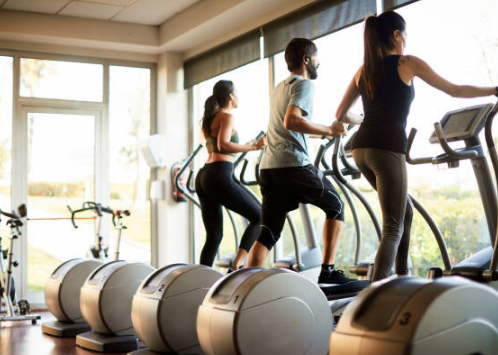Both elliptical machines and treadmills are useful equipment for exercising the cardiovascular system.
While both can be used to improve your fitness level, each modality has different mechanisms and specific uses that can target different muscle groups.

What Is Treadmill?
The basic purpose of a treadmill is to simulate walking or running by using a conveyor belt, allowing you to do the activity of your choice in place instead of moving your body forward in space.
It’s an effective way to exercise your cardiovascular system indoors, such as at the gym or at home. If you live in extremely hot or cold climates and can’t walk or run outdoors, then this can be a great solution.
Pros
There are several aspects of this treadmill that make it an excellent choice:
- You can set different levels of speed and inclination to change the intensity to the level that works best for you.
- Since the treadmill simulates walking or running, it will challenge your stability, coordination, and balance.
- Treadmills often have pre-programmed workout routines for those who need guidance to find workouts that are suitable for a specific purpose (e.g., endurance, anaerobic capacity, fat burning).
Cons
While there are many benefits to using a treadmill, there are also some drawbacks:
- Since the treadmill simulates running or walking, you may feel a lot of impact on your knees, hips, and ankles, which can be a problem for people with orthopedic problems.
- Since the treadmill is fixed, it feels monotonous and boring. It’s not as stimulating as walking or running outdoors.
- Placing a treadmill in your home takes up a lot of space and is expensive.
Despite the physical and mental detrimental effects of the monotony of treadmills, there are ways to address these issues.
To reduce impact on the joints, use a 1-5% slope, which can reduce direct pressure on the ankles, knees, and hips. To get rid of the boredom of a stationary workout, try watching a show or movie, or listening to a podcast or audiobook.
What Is Elliptical Machine?
An elliptical machine is another stationary piece of gym equipment that challenges your aerobic system by mimicking full-body movement without causing the same effect on your joints.
Pros
There are several advantages to elliptical machines that make them an excellent choice for improving physical fitness:
- While an elliptical can move your body and simulate walking or running, it doesn’t vibrate your joints like a treadmill does.
- An elliptical machine also works your upper body, which works the whole body better than a treadmill.
- An elliptical machine doesn’t require the same degree of coordination and balance as a treadmill, which makes it an excellent choice for people with stability issues.

Cons
While elliptical machines have many advantages, there are also some disadvantages:
- Elliptical machines are good for joints because they have a low impact. However, this means that you need adequate stimulation, including bearing more weight, to stimulate the body to form dense, strong, healthy bones.
- Since ellipticals don’t require much coordination, you’ll miss out on these challenges that provide the much-needed stimulus for long-term stability and balance.
- Like treadmills, elliptical machines can also take up space and be expensive.
Which One Is Better?
It’s unclear which one is better. Elliptical machines and treadmills have specific uses depending on individual needs and circumstances.
If you have joint problems or injuries, an elliptical may be a better fit for you. If you need more stability, balance, and coordination training, a treadmill can give you enough stimulation.
Both machines allow you to adjust the intensity of your workouts and challenge your cardiovascular system to the same extent. If you’re planning to buy one at home, they’ll also need a decent amount of space. The price of both devices varies depending on the brand you choose.
Target muscles
The elliptical machine targets the muscle groups in the lower and upper body, as well as in the core. The lower body muscle groups used during elliptical workouts include the quadriceps (especially rectus femoris), hamstrings, glutes, calves, and hip flexors. If you’re using your arms during an elliptical workout, the muscles targeted are the biceps, triceps, and deltoids.
Treadmills mainly work your lower limb muscles such as quadriceps, hamstrings, glutes, calves, tibials, and hip flexors. Upper body muscle groups are involved in fewer exercises than with an elliptical machine.
Size
Both of these types of gym equipment need to take up some space in the home. Sizes vary from model to model, so it’s important to consider the amount of space in your home when buying.
When using the device, it is important to measure and consider the height of the device and your height.
Calories burned
The number of calories you burn depends on the intensity and duration of your workout, not how you exercise.
While an elliptical may work more muscle groups than a treadmill, the intensity and duration of your workout are the main factors that affect how many calories you burn during your workout.
How to Choose?
When deciding which gym equipment to use or buy, consider:
- The individual’s orthopedic health and joint tolerance, influencing the optimal level of impact force
- Desired training goals
- Personal preference
- Size and space considerations
- Cost
Conclusion
Elliptical machines and treadmills are both training devices that help with long-term cardiovascular training. Both are stationary machines, which means they offer a convenient way to exercise indoors.
Choosing one or the other will depend on any existing joint problems or injuries and your workout goals.

